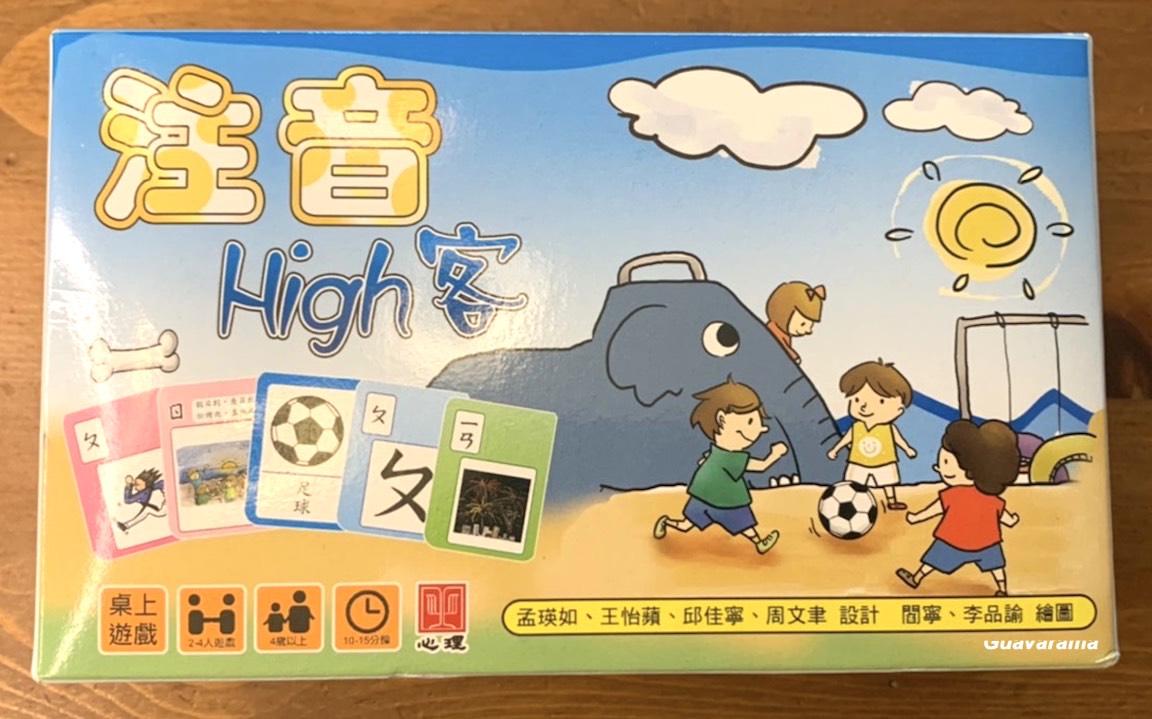Purpose: Learn zhuyin
Age: 3-9
In recent years, there has been a lot of new board games out there for learning zhuyin. Zhuyin High客 is one of my favorite. Though, how does one translate this into English? Zhuyin Hacker? Is this a play on sound?
Here’s the TL;DR. I like this game a lot and think it is a great tool for Chinese teachers as well as homeschoolers who want to add some fun to their zhuyin curriculum.
What is 注音 High 客?
注音 High 客 is a card game you can use to learn zhuyin.
When it comes to learning zhuyin, there are a few steps.
- Making children phonemically aware of the different sounds in Chinese. Typically this means beginning and ending sounds. But with Chinese, you also need awareness of tones.
- Learning to read the symbols attached to these sounds.
- Learning to blend simple sounds together. For zhuyin, it’s 2 zhuyin blends + tone.
- Blending 3 zhuyins together.
Note that for #3 and #4, there are actually 2 different skills as well, reading vs writing. And with Montessori philosophy, the writing goes first as she thinks that needing to read means you have to translate what you see first into a sound and then blend those sound together; vs. when you write, you already have the sounds of that word/character in your head and you just have to write the symbol you know for it. ¯\_(ツ)_/¯
Included in 注音 High 客 are the following cards:
- 37 zhuyin cards
- 37 zhuyin + picture cards (illustrate beginning sound)
- 74 picture + word cards (no zhuyin)
- 22 compound zhuyin cards
- 4 tone cards
- 3 wild cards

Most of the games included are used to learn how to “spell”; meaning the children look at the picture cards and think about the zhuyin that goes into it. So in a way, this is a very Montessori-esque designed game. The only complaint I have is that they should have color coded the zhuyin cards into vowels vs consonants.
There is also a companion workbook: 注音High客:我的注音遊戲書, which the child can use. This workbook is much like any of the zhuyin workbooks you can get out there, but I like how it’s grouped into different skills sections for the teacher to easily access, rather than all bunched together.
How to Play?
The game includes instructions for 6 different ways of playing.
I think the best is to watch the Youtube Videos from the publisher instead of reading their game rules. I will just cover the concept covered in each game.
- Game #1: Concept of phonics. See if you know any of the zhuyin that makes up a picture card.
- Game #2: Phonics and writing. Same as game #1, where you match any zhuyin sound in a picture card with laid out zhuyin cards.
- Game #3: Phonics. Match cards that have same sounds on table and in your hands. Works the best in matching beginning sounds.
- Game #4: Spelling. Throw out all the zhuyin cards in your hand that matches the spelling of the picture card on table.
- Game #5: Tones. Match tones of first character in picture card to 4 tone cards laid out on table.
- Game #5 alternate: Tones. Collect 3 picture cards each of 4 tones out of picture cards laid out on table.
- Game #6: Spelling. Take turn trying to create characters with each person only throwing out 1 zhuyin card at a time.
How Did I Use The Game?
During WSA18, I taught Fleur’s kid, Omi, some zhuyin using this game.
Funnily, we did NOT play most of the games included. Those games assume you understand the concept of blending (steps #3 & #4 I listed above). But most children need to first be introduced to beginning and ending sound concept. Thankfully, Chinese characters just have beginning and ending sounds, if you think of combo sounds like ㄧㄝ as one sound to teach.
I typically made up games that had the children matching beginning or ending sounds in picture cards to zhuyin cards.

Do I Recommend?
Yes. I do. This is a very well made game and there are many different ways you can use it on top of the 6 ways they provide. The inventor has a PH.D. in special education and I can see that they put a lot of thought in the design.
There is no zhuyin in the characters they provide, so the game itself requires that the teacher can read Chinese, as some of the pictures are not intuitive. It is especially suited for oversee Chinese kids that have already learned to read a lot of characters and is now learning zhuyin.
As I told my sister, who I’m passing the game off to for niece Spud, who is 4, to learn zhuyin, this is a great game if you play it with a preschooler consistently and persistently without trying to get teach so hard or trying to get something out of it.
Why? Because games should be fun. And when it’s fun, kids will want to keep playing and will learn if you’re patient and give it time. But if you’re there to correct them when they make a mistake and trying to get them to get some specific concept, then they may quickly lose interest.
Alternatively, for the Chinese teacher, it is a great tool to add a zhuyin to reinforce concepts when teaching elementary kids. For teachers, you should also get the companion workbook.
You can use this game to teach phonics awareness (beginning and ending sound), but it is especially suited for teaching how to blend. There is another game I will review which may be better suited for the preschooler for teaching to recognize individual zhuyin characters.
Where to Buy?
The easiest way is to buy this off of books.com.tw. There are two items you can buy.








